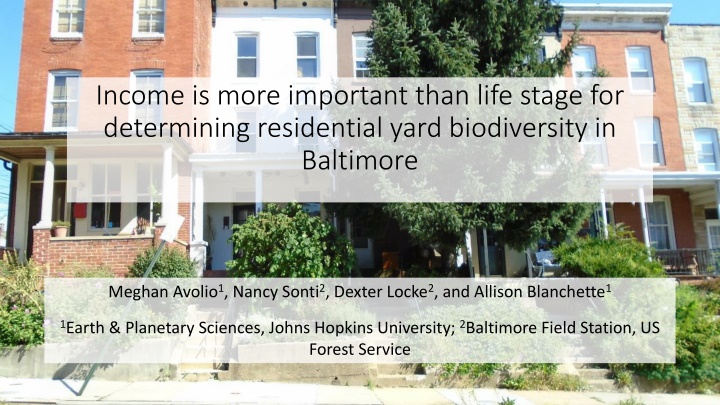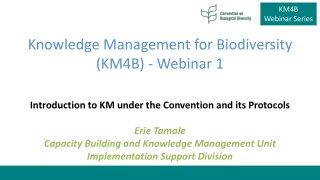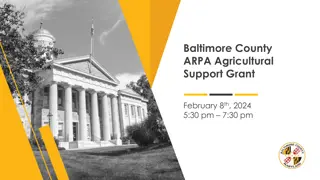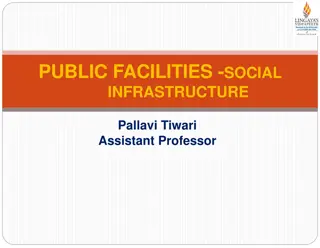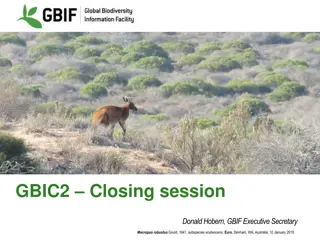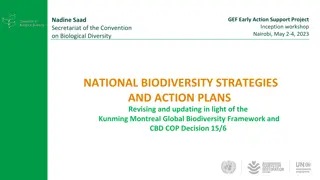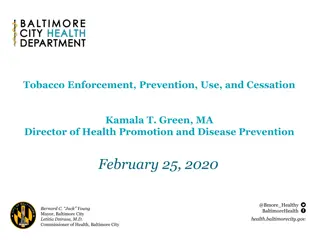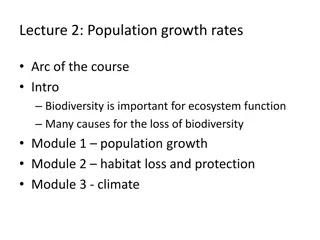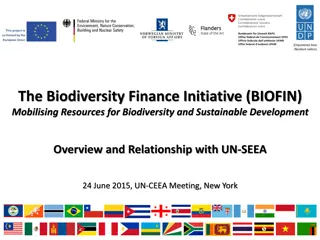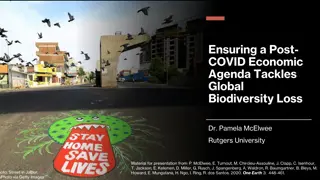Influence of Income on Residential Yard Biodiversity in Baltimore
Residential yards in Baltimore, regardless of life stage, exhibit variations in biodiversity based on residents' income levels rather than other factors. The study explores how time and money influence plant diversity in yards, hypothesizing that residents with less money but more time will have higher biodiversity. The research focuses on 12 Baltimore neighborhoods stratified by age and income levels to analyze the impact of resources on yard biodiversity.
Download Presentation

Please find below an Image/Link to download the presentation.
The content on the website is provided AS IS for your information and personal use only. It may not be sold, licensed, or shared on other websites without obtaining consent from the author.If you encounter any issues during the download, it is possible that the publisher has removed the file from their server.
You are allowed to download the files provided on this website for personal or commercial use, subject to the condition that they are used lawfully. All files are the property of their respective owners.
The content on the website is provided AS IS for your information and personal use only. It may not be sold, licensed, or shared on other websites without obtaining consent from the author.
E N D
Presentation Transcript
Income is more important than life stage for determining residential yard biodiversity in Baltimore Meghan Avolio1, Nancy Sonti2, Dexter Locke2, and Allison Blanchette1 1Earth & Planetary Sciences, Johns Hopkins University; 2Baltimore Field Station, US Forest Service
Residential yards are a human constructed ecosystem Baltimore Share similar features across a broad climatic gradient Lawn Flower beds Trees/shrubs Vegetable beds Los Angeles Salt Lake City
Residential yards are a human constructed ecosystem Salt Lake City Share similar features across a broad climatic gradient Lawn Flower beds Trees/shrubs Vegetable beds Lots of variation among yards Salt Lake City Salt Lake City
Do time and money influence plant biodiversity in residential yards? Human limiting resources: Time Money Abiotic limiting resources: Sunlight Water Nutrients
We hypothesize Time is money Residents that have less money but more time, will have more biodiversity Money is time Residents that do not have time can pay for someone to do their yard work Front vs. back yards are an important distinction More effort will be spent on front versus back yards
12 Baltimore neighborhoods were selected using Tapestry Segments Neighborhoods were stratified by: Time: younger and working (Middle Ground) vs. older retired (Senior Styles) Money: High (70-91K) vs. mid- income range (45-56K) Senior Styles Households are commonly married empty nesters or singles living alone Cell phones are popular, but so are landlines Many still prefer print to digital media Middle Ground Lifestyles of thirtysomethings Millennials in the middle: single/married Householders have ditched their landlines for cell phones Online all the time
12 Baltimore neighborhoods were selected using Tapestry Segments Neighborhoods were stratified by: Time: younger and working (Middle Ground) vs. older retired (Senior Styles) Money: High (70-91K) vs. mid- income range (45-56K) We also controlled for: Property age (built between 1910- 1969) Property size accounted for (small, medium and large lots used in each time-money combination)
We mailed surveys and did follow up visits to study yard vegetation Social Survey Data Mailed 1200 surveys to homeowners Sent follow up postcards Got back 192 surveys Yard Visits Went to 96 homes (8 per NB) Inventoried: Lawn biodiversity Tree diversity Flowering plant diversity
High income, Working High income, Retired Residential yards harbor high plant diversity 99 tree species 92 lawn species 95 flowering plant genera Mid-income, Working Mid-income, Retired
Summary of results Plant Response Variable Life Stage Income Front/Back Yard Size Interactions Lawn Richness Lawn Evenness Num. Trees Tree Richness Tree DBH Num. Flowering plants Num. Flowers Floral Genera Floral Area Num. Colors M*L T*L
Summary of results Plant Response Variable Life Stage IncomeFront/Back Yard Size Interactions Lawn Richness Lawn Evenness Num. Trees Tree Richness Tree DBH Num. Flowering plants Num. Flowers Floral Genera Floral Area Num. Colors LS * Loc.
Summary of results Plant Response Variable Life Stage IncomeFront/Back Yard Size Interactions Lawn Richness Lawn Evenness Num. Trees Tree Richness Tree DBH Num. Flowering plants Num. Flowers Floral Genera Floral Area Num. Colors LS * Loc.
Summary of results Plant Response Variable Life Stage Income Front/Back Yard Size Interactions Lawn Richness Lawn Evenness Num. Trees Tree Richness Tree DBH Num. Flowering plants Num. Flowers Floral Genera Floral Area Num. Colors LS * Loc.
Having more money was more important than having more time (and larger yards can support more plants)
Summary of results Plant Response Variable Life Stage Income Front/Back Yard Size Interactions Lawn Richness Lawn Evenness Num. Trees Tree Richness Tree DBH Num. Flowering plants Num. Flowers Floral Genera Floral Area Num. Colors LS * Loc.
Life stage was important for number of flowers and floral color area
Summary of results Plant Response Variable Life Stage Income Location Lawn Richness Lawn Evenness Num. Trees Tree Richness Tree DBH Num. Flowering plants Num. Flowers Floral Genera Floral Area Num. Colors Yard Size Interactions LS * Loc.
Yard location was important for some but not all yard plant biodiversity
Future research Time spent gardening # Species bought Fertilize? Plant diversity measure Income Irrigate? Preference for ____ Weed?
Conclusions Money is more important than life stage for yard biodiversity patterns Life stage was not a great proxy for time Life stage was important for number of flowers, suggesting learned gardening techniques Backyards had more trees, but front yards had more color Lawn management had no effect of lawn communities
Thank you! Participants Preston Betz Siraj Faruqee Eric Yee THREAD program
